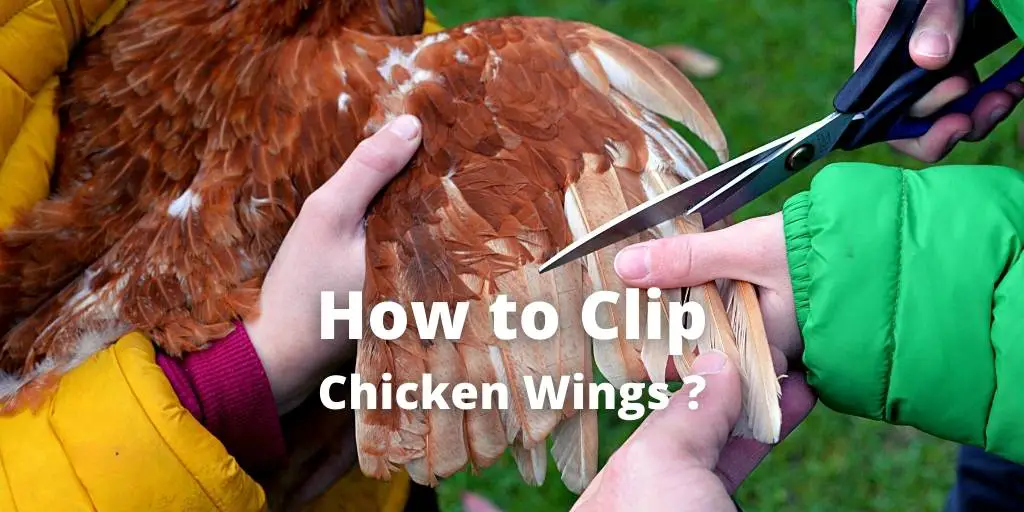How to clip chicken wings? It’s a question that chicken raisers ask who want to stop their chickens from flying.
It’s hard to control your chicken when it learns to jump over fences and fly to the neighbor house.
Not only roosters, hens are also prone to jump and cross your area if they wish to explore more food. Mostly free-range chickens fly and forage long.
You may need to clip their wings to control and stop their free-ranging area, flying over the fence.
This guide will tell you everything you need to know about clipping chicken wings, including the correct way to do it and common questions people have.
What Do You Mean by Clipping Chicken Wings?
Some chickens are never calm. They always like staying out of their coop. The ones that fly over the fence are the ones that require clipping.
Wings clipping is a process of cutting the long primary feathers of a chicken involved in flying. Trimming their wings will prevent them from jumping the fence and free-range in given area.
Few people say it cruelty. If there is no pain and clipping wings saves chicken’s life from outside predators, this is good for them.
Is It Necessary to Clip Chicken Wings?

The purpose of clipping a chicken’s wings is to prevent them from flying. Chickens can fly for short distances, but their wings aren’t strong enough to let them fly for a long time or very high.
By clipping their wings, we can secure them from escaping, getting lost or eaten by any predators.
Some people argue that it is not necessary to clip chicken wings because they cannot fly far or high anyway.
However, there is always the risk that a chicken will escape and get lost or hurt, so it is better to be safe than sorry. In the end, the decision of whether to clip chicken wings is up to the individual.
How to Clip Chicken Wings? Know the Correct Method.
For best results, two people are required when clipping the wings instead of one. The first person will hold the chicken comfortably and the second will trim the wings.
Equipment needed
Before you begin the clipping process, you must ensure you are equipped with the following tools.
- A pair of scissors – Ensure it is well sharpened since the wings are normally hard to cut.
- A clean towel – It is used to hold the chicken in a comfortable position and keeps safe from rooster spurs. The towel is optional.
- Corn starch – Though it is not a must, it is good to have it for safety in case the chicken bleeds. Corn starch blocks the bleeding in few seconds.
- First Aid Kit – This is required in case a mess happened during the process.
Feather Spreading
In feather spreading, you need to spread the chicken feathers to make your trimming easier. When spreading the feathers, you take one wing at a time.
Thereafter, you need to expose all the primary feathers. To spot the primary ones is easy, just pull the whole wing away from the chicken.
The wings will be longer than the others, they can have a different color. Furthermore, they are about 10 in number.
Trim Chicken Wings With Sharp Scissors
The first person will hold the chicken comfortably to avoid shaking its body. Then you begin cutting the wings about two-thirds of the feathers.
If you are unable to estimate the length, you can use the secondary wings to measure where to cut.
The goal is to cut the feathers without hurting the chicken. If you cut a bit deep, you will cut the blood vessels near the base of the feather, making the chicken bleed.
In case you mess up and cut much deep, you damage the feather permanently, meaning it will not grow again.
So, doing it correctly is most important. You can get help from an expert if you are afraid of doing this.
FAQs on Clipping Chicken Wings
Why Should You Clip Your Chicken Wings?
Chicken is normally kept in homes for egg production and even for meat. However, some chickens become more stubborn when they begin escaping from the cage.
A chicken can fly up to more than 6 ft, which makes it easy to fly over the fence. These chickens may later enter into neighbor’s yards and destroy even their garden.
Other reasons include the danger of flying. When a chicken flies over the fence, there might be a road just next. Coincidentally, when it is landing, a car may be passing and your chicken might be hurt.
Another reason for clipping the wings is for easier control of the flock. Flying chickens can move out of the compound, and they force you to go outside looking for them.
When to Clip Chicken Wings?
There is no specific time that you should start clippings the wings. This is because the chicken begins jumping even when they are small chicks.
At this stage, their wings have not yet stopped growing; hence they have blood capillaries. Before you think of clipping your hen’s wings, first consider checking the quill.
If it is dark, it means that the feathers are not yet completely developed and if you cut them, you will hurt the chicken.
How Often to Clip Chicken Wings?
Chickens usually have fast adaptability. When you first time trims the wings of a chicken that used to jump out, it will first try to do the normal thing for some days.
It will then note that it can’t jump again until when the feathers grow again. Here, it will start practicing its bad habits again.
Therefore, you need to clip its wings for some time until it forgets the habit. From there, you will only be required to clip them if you are moving them to another area or after a long time they start jumping again.
Can Chicken Still Roost With Clipped Wings?
It is a common practice to clip a chicken’s wings in order to prevent it from flying. However, this does not mean that the chicken will be unable to roost.
Chickens typically roost by perching on a high surface, such as a branch or beam. Even with clipped wings, a chicken will be able to flutter its way up to a roosting spot.
However, wings also help to maintain balance when roosting. Therefore, you need to maintain your clipping not to go so deep into the hen’s body.
So, while chickens with clipped wings cannot fly, they can still roost. This is just one more way that chickens can adapt to their environment and continue to thrive.
Is It Safe to Trim Chicken Wings by Yourself?
Although chicken wings and feathers can be clipped by yourself, it is recommended to have someone else help you.
This is because chicken wings and feathers can pose a safety hazard if not clipped correctly.
If you are not comfortable clipping chicken wings and feathers by yourself, then it is best to ask someone else to help you.
Is Cutting Chicken Wings to Stop Flocks Flying Over the Fence?
Poultry farmers have long used a variety of methods to stop chickens from flying over fences and into neighboring properties.
One common method is to trim the chickens’ wings, which prevents them from achieving lift and makes it more difficult for them to escape the confines of the farm.
But does this method actually work? Some studies have shown that trimmed wings can still allow chickens to fly short distances, and there is no guarantee that they will stay within the property boundaries.
So while trimming chicken wings may be a common way to prevent them from escaping, it is not a foolproof method.
Summary
Clipping chicken wings is a process of trimming the wing tips off of the chicken’s wings. This is typically done in order to prevent the chicken from flying, but it can also help to keep the chicken’s feathers clean and tidy.
There are various ways to clip chicken wings, but the most common method is to use a pair of sharp scissors.
First, the chicken’s wing tips are located, and then the scissors are used to snip off the tips. It is important to be careful when clipping chicken wings, as you want to avoid cutting too deep and injure the chicken.
Once the chicken’s wings have been clipped, the feathers will be shorter and the chicken will be unable to fly. However, they will still be able to roost, walk and run around, and their feathers will eventually grow back since it’s not permanent.


